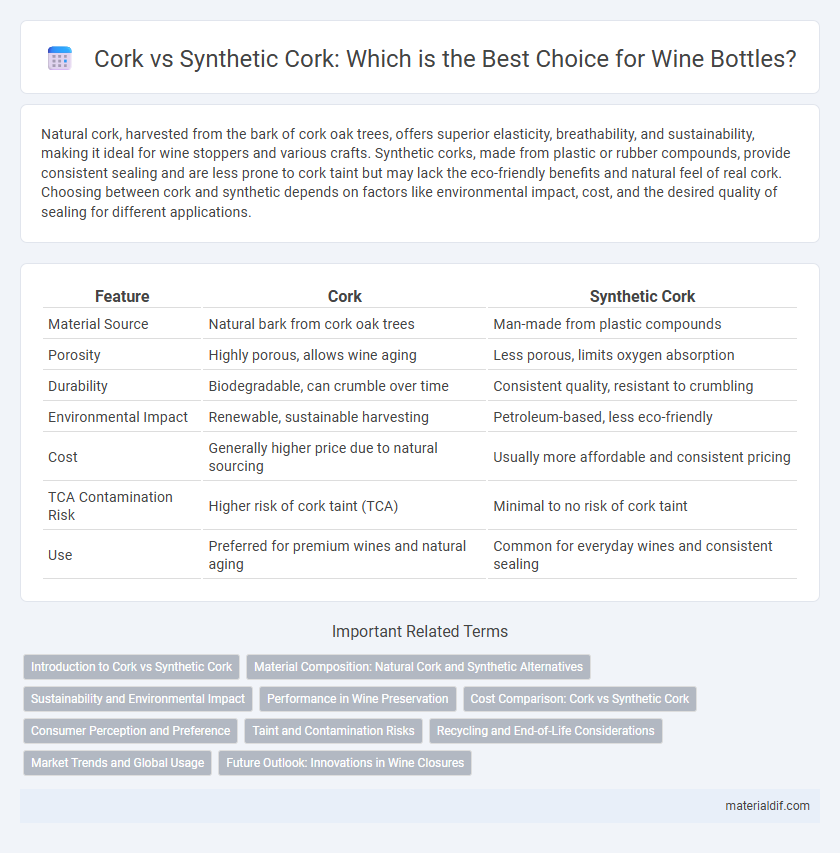Natural cork, harvested from the bark of cork oak trees, offers superior elasticity, breathability, and sustainability, making it ideal for wine stoppers and various crafts. Synthetic corks, made from plastic or rubber compounds, provide consistent sealing and are less prone to cork taint but may lack the eco-friendly benefits and natural feel of real cork. Choosing between cork and synthetic depends on factors like environmental impact, cost, and the desired quality of sealing for different applications.
Table of Comparison
| Feature | Cork | Synthetic Cork |
|---|---|---|
| Material Source | Natural bark from cork oak trees | Man-made from plastic compounds |
| Porosity | Highly porous, allows wine aging | Less porous, limits oxygen absorption |
| Durability | Biodegradable, can crumble over time | Consistent quality, resistant to crumbling |
| Environmental Impact | Renewable, sustainable harvesting | Petroleum-based, less eco-friendly |
| Cost | Generally higher price due to natural sourcing | Usually more affordable and consistent pricing |
| TCA Contamination Risk | Higher risk of cork taint (TCA) | Minimal to no risk of cork taint |
| Use | Preferred for premium wines and natural aging | Common for everyday wines and consistent sealing |
Introduction to Cork vs Synthetic Cork
Natural cork, harvested from the bark of cork oak trees predominantly found in Portugal and Spain, offers superior elasticity, breathability, and sustainability compared to synthetic cork made from plastic polymers. Synthetic cork, designed to mimic natural cork's appearance and function, provides consistent quality and resistance to crumbling but often lacks the eco-friendliness and long-term aging benefits of natural cork. The choice between natural cork and synthetic alternatives significantly impacts wine preservation, environmental footprint, and overall sensory experience.
Material Composition: Natural Cork and Synthetic Alternatives
Natural cork, harvested from the bark of Quercus suber trees, offers a unique cellular structure that provides elasticity, compressibility, and excellent oxygen permeability for wine preservation. Synthetic corks, often made from plastics such as polyethylene or EVA copolymers, attempt to replicate these features but lack the natural microstructure, leading to differences in sealing performance and aging characteristics. While natural cork supports sustainability through renewable harvesting practices, synthetic corks provide consistent material composition and resistance to cork taint, influencing their selection in wine bottling.
Sustainability and Environmental Impact
Natural cork, harvested from the bark of cork oak trees, offers exceptional sustainability due to its renewable growth cycle and carbon sequestration properties, making it an eco-friendly choice for wine stoppers and other uses. Synthetic corks, made from petroleum-based plastics, contribute to environmental pollution and are less biodegradable, posing challenges for recycling and landfill waste management. Cork harvesting supports biodiversity and local economies in cork oak regions, whereas synthetic alternatives increase reliance on fossil fuels and generate higher carbon footprints.
Performance in Wine Preservation
Natural cork offers superior oxygen permeability, allowing gradual micro-oxygenation that enhances wine aging and complexity. Synthetic corks provide a more airtight seal, which prevents oxidation but can hinder the wine's maturation process. For long-term wine preservation, natural cork generally outperforms synthetic alternatives due to its adaptive breathability and proven track record in maintaining wine quality.
Cost Comparison: Cork vs Synthetic Cork
Natural cork, harvested from cork oak trees primarily in Portugal and Spain, typically costs more due to sustainable harvesting methods and its renewable nature. Synthetic corks, made from plastics and polymers, are generally less expensive to produce and purchase, offering cost efficiency for high-volume bottlers. However, natural cork's biodegradability and premium market perception often justify the higher price compared to synthetic alternatives.
Consumer Perception and Preference
Consumers often perceive natural cork as a premium, eco-friendly option due to its renewable sourcing and biodegradability, enhancing its appeal in wine bottle closures. Synthetic corks, while appreciated for consistency and the elimination of cork taint risks, tend to be viewed as less authentic and less environmentally sustainable by many wine enthusiasts. Market studies reveal a strong preference for natural cork in premium wine segments, driven by tradition and sensory attributes linked to natural materials.
Taint and Contamination Risks
Natural cork, harvested from cork oak trees predominantly in Portugal and Spain, is known for its low risk of taint and contamination due to its organic, breathable structure that allows wine to mature without off-flavors. Synthetic corks, made from plastic compounds like polyethylene or elastomers, can pose higher risks of taint as they may leach chemicals or foster unwanted microbial growth if not manufactured under strict quality controls. The presence of TCA (2,4,6-trichloroanisole) in natural cork is a well-documented cause of cork taint, but innovations in cork processing have significantly reduced contamination incidents compared to earlier decades.
Recycling and End-of-Life Considerations
Natural cork is biodegradable and can be recycled into various products such as flooring and insulation, reducing landfill waste and environmental impact. Synthetic corks, typically made from plastic or rubber compounds, are non-biodegradable and pose significant recycling challenges, often ending up in landfills or incinerators. Cork's sustainable lifecycle supports circular economy initiatives, while synthetic alternatives contribute to long-term environmental burdens due to limited end-of-life options.
Market Trends and Global Usage
Natural cork maintains strong demand in global wine markets due to its sustainability and traditional appeal, accounting for about 70% of cork stoppers worldwide. Synthetic corks, valued for consistency and cost-effectiveness, have seen increased adoption in regions like North America and Asia, capturing roughly 25% of market share. Market trends indicate a growing shift toward eco-friendly alternatives, yet natural cork remains dominant in premium wine sectors.
Future Outlook: Innovations in Wine Closures
Cork remains a sustainable and renewable resource with ongoing innovations like micro-agglomerated corks enhancing performance and reducing imperfections. Synthetic corks continue to evolve, offering consistency and eliminating cork taint, appealing to large-scale producers seeking reliability. Future developments will likely blend natural and synthetic materials to optimize preservation, sustainability, and consumer preferences in wine closures.
Cork vs Synthetic Cork Infographic

 materialdif.com
materialdif.com